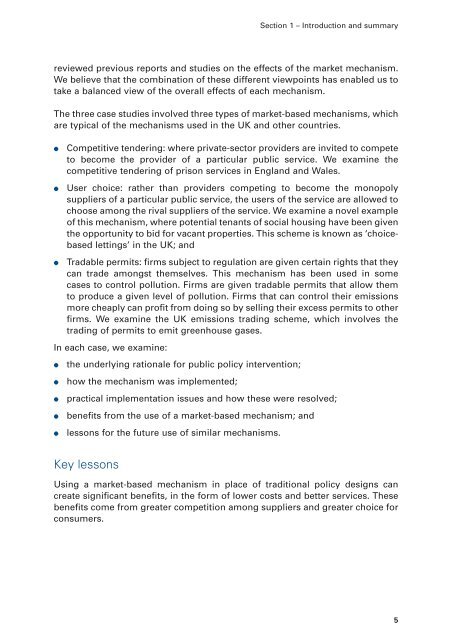Public Policy: Using Market-Based Approaches - Department for ...
Public Policy: Using Market-Based Approaches - Department for ...
Public Policy: Using Market-Based Approaches - Department for ...
Create successful ePaper yourself
Turn your PDF publications into a flip-book with our unique Google optimized e-Paper software.
eviewed previous reports and studies on the effects of the market mechanism.<br />
We believe that the combination of these different viewpoints has enabled us to<br />
take a balanced view of the overall effects of each mechanism.<br />
The three case studies involved three types of market-based mechanisms, which<br />
are typical of the mechanisms used in the UK and other countries.<br />
● Competitive tendering: where private-sector providers are invited to compete<br />
to become the provider of a particular public service. We examine the<br />
competitive tendering of prison services in England and Wales.<br />
● User choice: rather than providers competing to become the monopoly<br />
suppliers of a particular public service, the users of the service are allowed to<br />
choose among the rival suppliers of the service. We examine a novel example<br />
of this mechanism, where potential tenants of social housing have been given<br />
the opportunity to bid <strong>for</strong> vacant properties. This scheme is known as ‘choicebased<br />
lettings’ in the UK; and<br />
● Tradable permits: firms subject to regulation are given certain rights that they<br />
can trade amongst themselves. This mechanism has been used in some<br />
cases to control pollution. Firms are given tradable permits that allow them<br />
to produce a given level of pollution. Firms that can control their emissions<br />
more cheaply can profit from doing so by selling their excess permits to other<br />
firms. We examine the UK emissions trading scheme, which involves the<br />
trading of permits to emit greenhouse gases.<br />
In each case, we examine:<br />
● the underlying rationale <strong>for</strong> public policy intervention;<br />
● how the mechanism was implemented;<br />
● practical implementation issues and how these were resolved;<br />
● benefits from the use of a market-based mechanism; and<br />
● lessons <strong>for</strong> the future use of similar mechanisms.<br />
Key lessons<br />
Section 1 – Introduction and summary<br />
<strong>Using</strong> a market-based mechanism in place of traditional policy designs can<br />
create significant benefits, in the <strong>for</strong>m of lower costs and better services. These<br />
benefits come from greater competition among suppliers and greater choice <strong>for</strong><br />
consumers.<br />
5
















